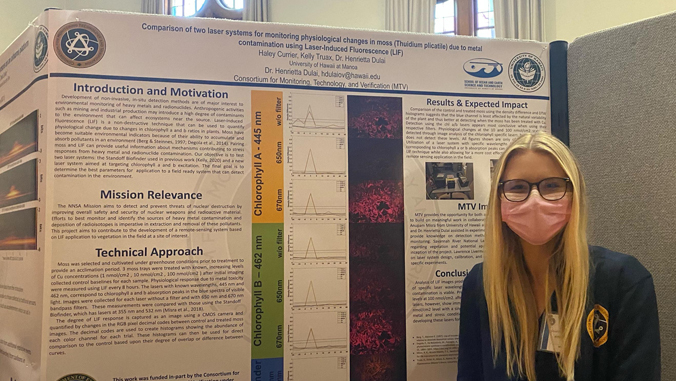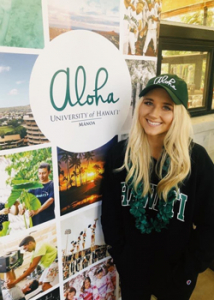
A University of Hawaiʻi at Mānoa undergraduate’s research project could eventually lead to better environmental contamination detection. Earth sciences major Haley Currier was awarded funding from the Undergraduate Research Opportunities Program (UROP) to support her project that will test two laser systems’ ability to detect physiological changes in Azolla, a type of waterfern, caused by lead contamination and determine how these systems can be further used.
UROP provides merit-based scholarship funds to UH Mānoa undergraduate students who successfully propose a faculty-mentored research or creative work project.
Currier, who has wanted to be a scientist since the first grade, will work in Earth sciences professor Henrietta Dulai’s laboratory with doctoral student Kelly Truax. The ultimate goal of this project is to test the capabilities of the lasers at various distances and light conditions and to determine the plant’s sensitivity to different concentrations of heavy metals.

The UROP project grew out of Currier’s prior experience assisting Truax with her research on heavy metal detection in moss using Laser-Induced-Fluorescence (LIF). Currier helped run experiments and collect data, performed computer coding, and eventually created a poster that she presented at the Consortium for Monitoring Technology, and Verification (MTV) conference in Michigan.
MTV is a consortium of 14 universities, including UH Mānoa, and 13 national laboratories whose mission is to develop new technologies that detect and deter nuclear proliferation activities and to train the next generation of nuclear professionals.
“Learning about the work that Kelly has done using LIF and getting to work alongside her have been my favorite parts of my job,” said Currier. “Presenting at the MTV conference was one of the most rewarding moments of our research—and my life! Never did I believe that I’d be able to work with such a great group of people and learn so much at the same time.”
Originally from San Clemente, California, Currier said, “Growing up, I collected and studied rocks from my backyard and my love for nature only grew with time. I decided to get my degree in Earth science because of my passion for preserving our planet and learning more about the world around us.”
For more information, see School of Ocean and Earth Science and Technology’s website.
–Marcie Grabowski

